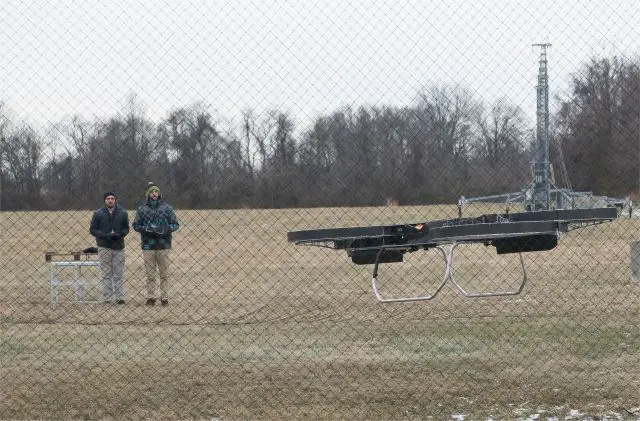Breaking news
Quadcopter hoverbike JTARV demonstrated by U.S. Army Research Laboratory 12201172.
|
|
|||
|
Defence & Security News - United States
|
|||
|
|
|||
|
Quadcopter " hoverbike " JTARV demonstrated by U.S. Army Research Laboratory.
|
|||
|
The U.S. Army Research Laboratory and industry partners demonstrated the flying capabilities of a unique rectangular-shaped quadcopter also named the "hoverbike" joint tactical aerial resupply vehicle, or JTARV. during a visit from Department of Defense officials January 10, 2017.
|
|||
|
|
|||
 U.S. Army researchers and industry partners fly a prototype rectangular-shaped quadcopter during a visit from DOD officials to Aberdeen Proving Ground, Maryland, Jan. 10, 2017. (Photo Credit: Jhi Scott, ARL) U.S. Army researchers and industry partners fly a prototype rectangular-shaped quadcopter during a visit from DOD officials to Aberdeen Proving Ground, Maryland, Jan. 10, 2017. (Photo Credit: Jhi Scott, ARL) |
|||
|
|
|||
|
Dr. William Roper, director of the Strategic Capabilities Office at the Office of the Secretary of Defense and members of his staff visited the Aberdeen Proving Ground laboratory to see the joint tactical aerial resupply vehicle, or JTARV. Also known as the "hoverbike," the vehicle may one day make it possible for Soldiers on the battlefield to order resupply and then receive those supplies rapidly. During the visit, Roper told laboratory officials that he is concerned about adapting future technology advances. He said he wants to figure out how to get people to "see something that's coming on the shelf, immediately identify the use, determine if it's good enough for rock and roll, get it into the field, but in a way that allows us to keep one-upping it." Researchers envision a future JTARV flying low to the ground or at thousands of feet at speeds of 60 miles per hour or more.
|
|||
|
|
|||
 Sgt. 1st Class Daniel Guenther (right), U.S. Army Research Laboratory, shows the Joint Tactical Aerial Resupply Vehicle Model P-200 to DOD Strategic Capabilities Office Director Dr. William Roper (center) at Aberdeen Proving Ground, Maryland, Jan. 10, 2017. (Photo Credit: Jhi Scott, ARL) Sgt. 1st Class Daniel Guenther (right), U.S. Army Research Laboratory, shows the Joint Tactical Aerial Resupply Vehicle Model P-200 to DOD Strategic Capabilities Office Director Dr. William Roper (center) at Aberdeen Proving Ground, Maryland, Jan. 10, 2017. (Photo Credit: Jhi Scott, ARL) |
|||
|
|
|||
|
While the current prototype is electric, researchers are looking at a hybrid propulsion system that could dramatically increase range.
The U.S. engineers explores to increase the payload capacity to 800 pounds (362 kg) and extending the range up to 125 miles (around 200 km) and to integrate advanced intelligent navigation and mission planning. The laboratory began exploring the JTARV concept in the summer of 2014. They identified a manufacturer, Malloy Aeronautics, and a systems integrator, SURVICE, entered into a contract and moved quickly from concept to full-scale prototypes. The JTARV is now a joint effort with the Marine Corps, led by Army researchers, at the Army Armament Research, Development and Engineering Center at Picatinny Arsenal, New Jersey; however, the ARL researchers still serve as subject matter experts on aeromechanics, assessment, analysis, propulsion, intelligence and controls and materials and structures.
|
|||

























